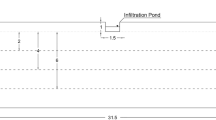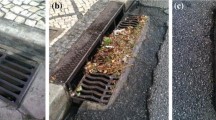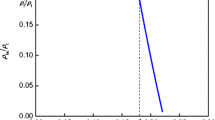Abstract
The progressive increase of impervious surfaces induced by urbanization altered significantly the natural hydrological cycle of urban catchments. To face the need of more sustainable and effective solutions for stormwater management and planning, Low Impact Development (LID) practices have been frequently proposed to support existing urban drainage systems. Among LID infrastructures, design and management of stormwater infiltration facilities are still characterised by a high degree of uncertainty. Since the stochastic heterogeneity of the soil may affect significantly their hydraulic performance, it is crucial to understand whether it should be accounted for in the design process. To this aim, numerical experiments under transient variably water saturated conditions were performed. Four infiltration facilities of different bottom length subjected to the same spatial variability of the intrinsic permeability field were considered. Simulations showed that the effects of stochastic heterogeneity on the hydraulic performance are dependent on the dimensions of the facility and on the correlation lengths of the intrinsic permeability field. These effects may potentially undermine the capacity to capture stormwater. To be reduced, the bottom dimensions of the facility should be higher than the horizontal correlation lengths of the intrinsic permeability field. Most strikingly, whether the stochastic heterogeneity is considered or not, the volume infiltrated through the bottom follows an increasing power law with increasing bottom length, while the average infiltration rate at the bottom follows a decaying power law.










Similar content being viewed by others
Change history
19 November 2019
The original version of this article unfortunately contains mistakes introduced during the publishing process. The mistakes and corrections are described in the following list, the main error lies in Table 1, page 2402.
References
Ahiablame L, Shakya R (2016) Modeling flood reduction effects of low impact development at a watershed scale. J Environ Manag 171:81–91
Ahiablame LM, Engel BA, Chaubey I (2012) Effectiveness of low impact development practices: literature review and suggestions for future research. Water Air Soil Pollut 223(7):4253–4273
Armitage N, Vice M, Fisher-Jeffes L, Winter K, Spiegel A, Dunstan J (2013) The South African guidelines for sustainable drainage systems. Report TT558/13. Water Research Commission, Pretoria
Barbosa AE, Hvitved-Jacobsen T (2001) Infiltration pond design for highway runoff treatment in semiarid climates. J Environ Eng 127(11):1014–1022
Barron OV, Barr AD, Donn MJ (2013) Effect of urbanisation on the water balance of a catchment with shallow groundwater. J Hydrol 485:162–176
Bear J (1972) Dynamics of fluids in porous media. Dover Publications, Inc, New York
Bhaduri B, Harbor J, Engel B, Grove M (2000) Assessing watershed-scale, longterm hydrologic impacts of land-use change using a GIS-NPS model. Environ Manag 26(6):643–658
Braester C, Dagan G, Neuman SP, Zaslavsky D (1971) A survey of the equations and solutions of unsaturated flow in porous media. First Annu. Rep. Project A10-SWC-77, 176 pp, Hydraulic Engineering Laboratory, Technion, Israel
Caltrans (California Department of Transportation) (2000) Stormwater quality handbook, project training and design guide. Sacramento. URL:http://www.dot.ca.gov/manuals.html
Carleton GB (2010) Simulation of groundwater mounding beneath hypothetical stormwater infiltration basins. U.S. Geological Survey Scientific Investigations Report 2010–5102, p 64
CEI (Comprehensive Environmental Inc.) (2008) New Hampshire stormwater manual. Volume 1: stormwater and antidegradation. NH, Concord Comprehensive Environmental Inc. & New Hampshire Department of Environmental Services. WD-08-20A
Celia MA, Bouloutas ET, Zarba RL (1990) A general mass-conservative numerical solution for the unsaturated flow equation. Water Resour Res 26(7):1483–1496
Coffman LS (2002) Low-impact development: an alternative stormwater management technology. In: France RL (ed) Handbook of water sensitive planning and design. Lewis, Washington, D.C., pp 97–124
Cooley RL (1971) A finite difference method for unsteady flow in variably saturated porous media: application to a single pumping well. Water Resour Res 7(6):1607–1625
D’Aniello A, Hartog N, Sweijen T, Pianese D (2018) Infiltration and distribution of elemental mercury DNAPL in water-saturated porous media: experimental and numerical investigation. Water Air Soil Pollut 229(1):25. https://doi.org/10.1007/s11270-017-3674-0
D’Aniello A, Cimorelli L, Cozzolino L, Pianese D (2019) The effect of geological heterogeneity and groundwater table depth on the hydraulic performance of stormwater infiltration facilities. Water Resour Manag 33(3):1147–1166. https://doi.org/10.1007/s11269-018-2172-5
D'Aniello A (2017) The flow behaviour of elemental mercury DNAPL in porous media. PhD Thesis, Università degli Studi di Napoli Federico II. https://doi.org/10.6093/UNINA/FEDOA/11617
Davis AP (2005) Green engineering principles promote low impact development. Environ Sci Technol 39(16):338A–344A
Dekker TJ, Abriola LM (2000) The influence of field-scale heterogeneity on the infiltration and entrapment of dense nonaqueous phase liquids in saturated formations. J Contam Hydrol 42(2):187–218
Deutsch CV, Journel AG (1997) GSLIB: geostatistical software library and user’s guide, 2nd edn. Oxford university press, Oxford
Diersch HJG (2013) FEFLOW: finite element modeling of flow, mass and heat transport in porous and fractured media. Springer Science & Business Media, Berlin
Dietz ME, Clausen JC (2008) Stormwater runoff and export changes with development in a traditional and low impact subdivision. J Environ Manag 87(4):560–566
Duchene M, McBean EA, Thomson NR (1994) Modeling of infiltration from trenches for storm-water control. J Water Resour Plan Manag 120(3):276–293
FHWA (Federal Highway Administration) (1996) Urban design drainage manual. Hydrologic Engineering Circular No. 22, Washington DC
Gelhar LW (1993) Stochastic subsurface hydrology. Prentice-Hall, Englewood Cliffs
Haghighatafshar S, Nordlöf B, Roldin M, Gustafsson LG, la Cour Jansen J, Jönsson K (2018) Efficiency of blue-green stormwater retrofits for flood mitigation–conclusions drawn from a case study in Malmö, Sweden. J Environ Manag 207:60–69
Han D, Currell MJ, Cao G, Hall B (2017) Alterations to groundwater recharge due to anthropogenic landscape change. J Hydrol 554:545–557
Harbor J (1994) A practical method for estimating the impact of land-use change on surface runoff, groundwater recharge, and wetland hydrology. J Am Plan Assoc 60(1):95–108
HUD (U.S. Department of Housing and Urban Development) (2003) The practice of low impact development. Office of Policy Development and Research. Washington, D.C. Report prepared by NAHB Research Center, Inc. Contract No. H-21314CA
Hunt WF, Traver RG, Davis AP, Emerson CH, Collins KA, Stagge JH (2010) Low impact development practices: designing to infiltrate in urban environments. In: Chang N (ed) Effects of urbanization on groundwater. ASCE, Environmental Water Resources Institute, Reston, pp 308–343
Huyakorn PS, Thomas SD, Thompson BM (1984) Techniques for making finite elements competitve in modeling flow in variably saturated porous media. Water Resour Res 20(8):1099–1115
Istok JD (1989) Groundwater modelling by the finite element method. Water Resources Monograph, 13, American Geophysical Union, 2000 Florida Avenue, NW, Washington, DC 2000
Konrad CP (2014) Effects of urban development on floods. U.S. Geological Survey. Fact Sheet 076e03
Kueper BH, Frind EO (1991) Two-phase flow in heterogeneous porous media: 2. Model application. Water Resour Res 27(6):1059–1070
Leverett M (1941) Capillary behavior in porous solids. Trans AIME 142(01):152–169
Li H (2015) Green infrastructure for highway stormwater management: field investigation for future design, maintenance, and management needs. J Infrastruct Syst 21(4):05015001
Massmann JW (2003) Implementation of infiltration ponds research. Final Research Report (No. WA-RD 578.1), Washington State Department of Transportation
MDE (Maryland Department of the Environment) (1998) Maryland stormwater design manual. Center for Watershed Protection, Annapolis
Minnesota Stormwater Steering Committee (2005) The Minnesota stormwater manual. Minnesota Pollution Control Agency, St. Paul
Mualem Y (1976) A new model for predicting the hydraulic conductivity of unsaturated porous media. Water Resour Res 12(3):513–522
Newcomer ME, Gurdak JJ, Sklar LS, Nanus L (2014) Urban recharge beneath low impact development and effects of climate variability and change. Water Resour Res 50:1716–1734
Olea RA (1999) Geostatistics for engineers and earth scientists. Springer Science & Business Media, New York
Palla A, Gnecco I (2015) Hydrologic modeling of low impact development systems at the urban catchment scale. J Hydrol 528:361–368
Price K (2011) Effects of watershed topography, soils, land use, and climate on baseflow hydrology in humid regions: a review. Prog Phys Geogr 35(4):465–492
Qin HP, Li ZX, Fu G (2013) The effects of low impact development on urban flooding under different rainfall characteristics. J Environ Manag 129:577–585
Rathfelder K, Abriola LM (1994) Mass conservative numerical solutions of the head-based Richards equation. Water Resour Res 30(9):2579–2586
Richards LA (1931) Capillary conduction of liquids through porous mediums. J Appl Phys 1(5):318–333
Rujner H, Leonhardt G, Marsalek J, Perttu AM, Viklander M (2018) The effects of initial soil moisture conditions on swale flow hydrographs. Hydrol Process 32:644–654
Schoonover JE, Lockaby BG, Helms BS (2006) Impacts of land cover on stream hydrology in the West Georgia piedmont, USA. J Environ Qual 35(6):2123–2131
Sudicky EA (1986) A natural gradient experiment on solute transport in a sand aquifer: spatial variability of hydraulic conductivity and its role in the dispersion process. Water Resour Res 22(13):2069–2082
Thompson A, Nimmer M, Misra D (2010) Effects of variations in hydrogeological parameters on water-table mounding in sandy loam and loamy sand soils beneath stormwater infiltration basins. Hydrogeol J 18(2):501–508
Thoms RB, Johnson RL, Healy RW (2006) User's guide to the Variably Saturated Flow (VSF) process to MODFLOW (No. 6-A18)
USEPA (US Environmental Protection Agency) (2000) Low impact development (LID). In: A literature review. Office of Water, Washington, D.C EPA-841-B-00-005
USGS (U.S. Geological Survey) (1999) The quality of our nation’s waters-nutrients and pesticides. U.S. Geological Survey Circular 1225, U.S. Geological Survey, Reston, Virginia
van Genuchten MT (1980) A closed-form equation for predicting the hydraulic conductivity of unsaturated soils. Soil Sci Soc Am J 44(5):892–898
Vauclin M, Khanji D, Vachaud G (1979) Experimental and numerical study of a transient, two-dimensional unsaturated-saturated water table recharge problem. Water Resour Res 15(5):1089–1101
Washington State Department of Ecology (2001) Stormwater management manual for Western Washington. Publication 99–13, Olympia, WA
Yang Z, Zandin H, Niemi A, Fagerlund F (2013) The role of geological heterogeneity and variability in water infiltration on non-aqueous phase liquid migration. Environ Earth Sci 68(7):2085–2097
Author information
Authors and Affiliations
Corresponding author
Ethics declarations
Conflict of Interest
None.
Additional information
Publisher’s Note
Springer Nature remains neutral with regard to jurisdictional claims in published maps and institutional affiliations.
Rights and permissions
About this article
Cite this article
D’Aniello, A., Cimorelli, L. & Cozzolino, L. The Influence of Soil Stochastic Heterogeneity and Facility Dimensions on Stormwater Infiltration Facilities Performance. Water Resour Manage 33, 2399–2415 (2019). https://doi.org/10.1007/s11269-019-02268-x
Received:
Accepted:
Published:
Issue Date:
DOI: https://doi.org/10.1007/s11269-019-02268-x




